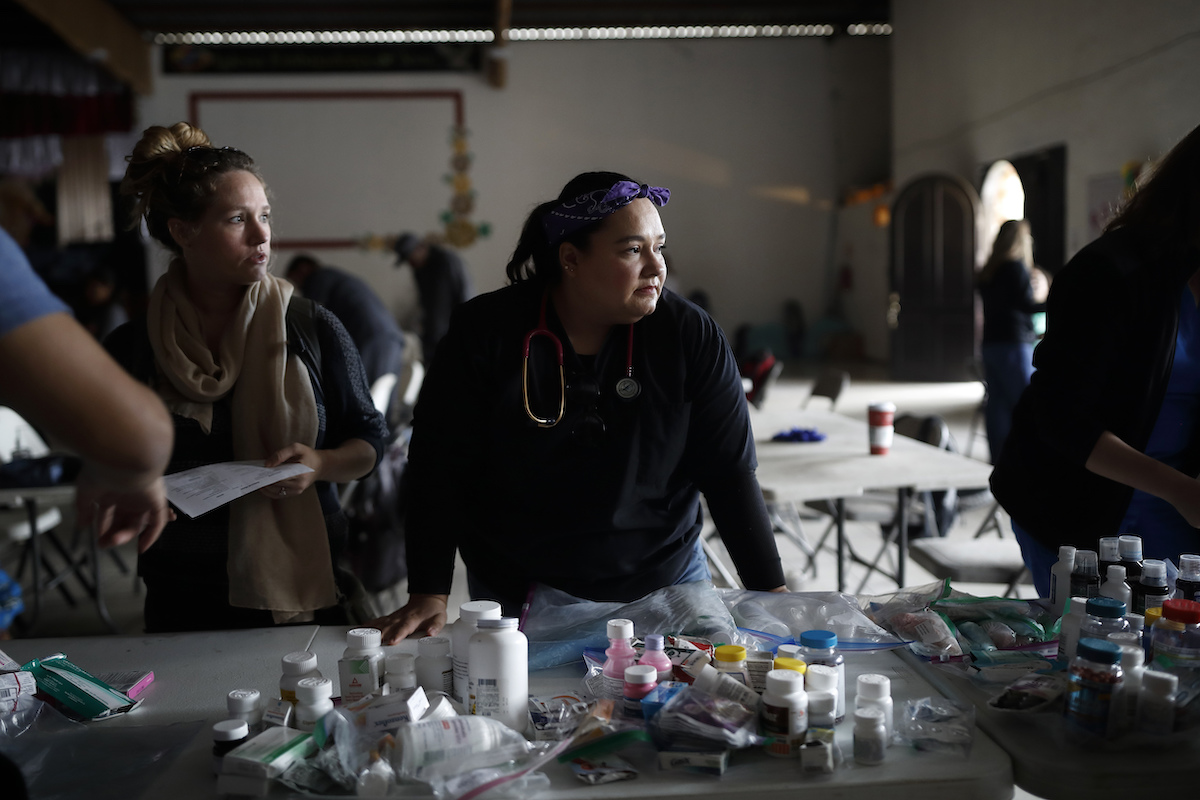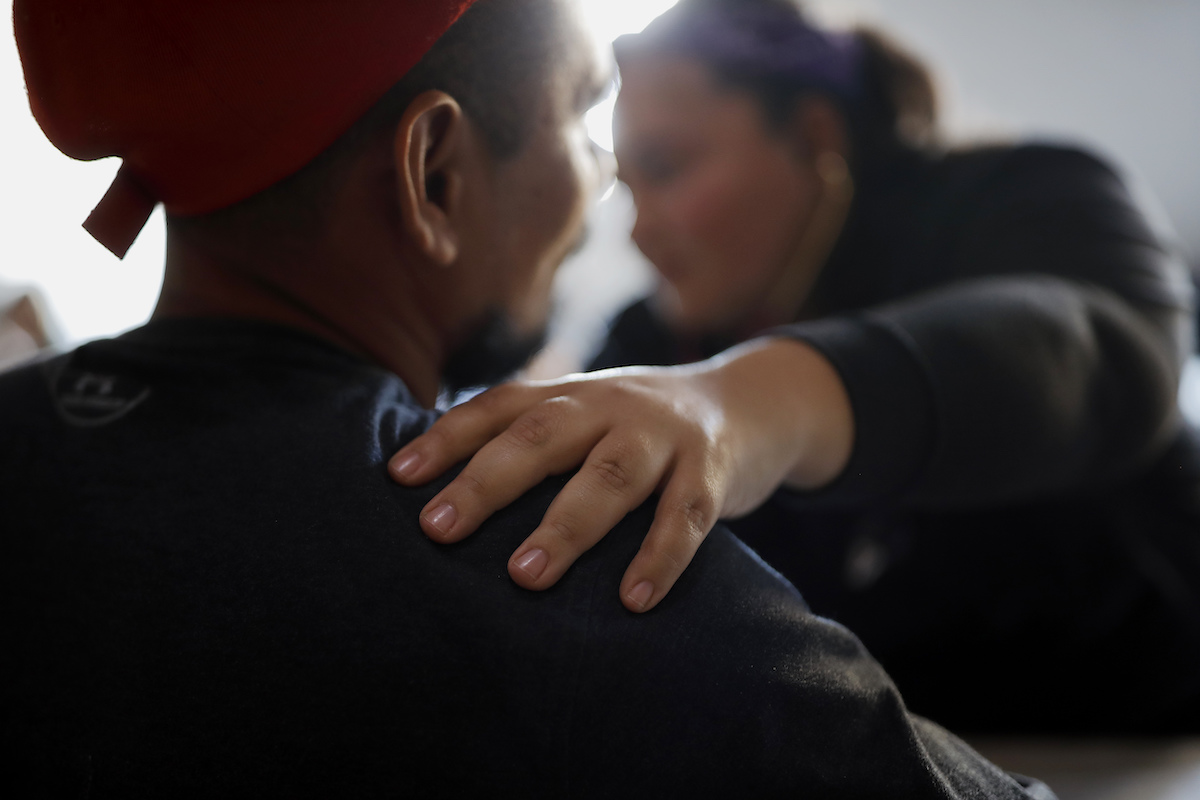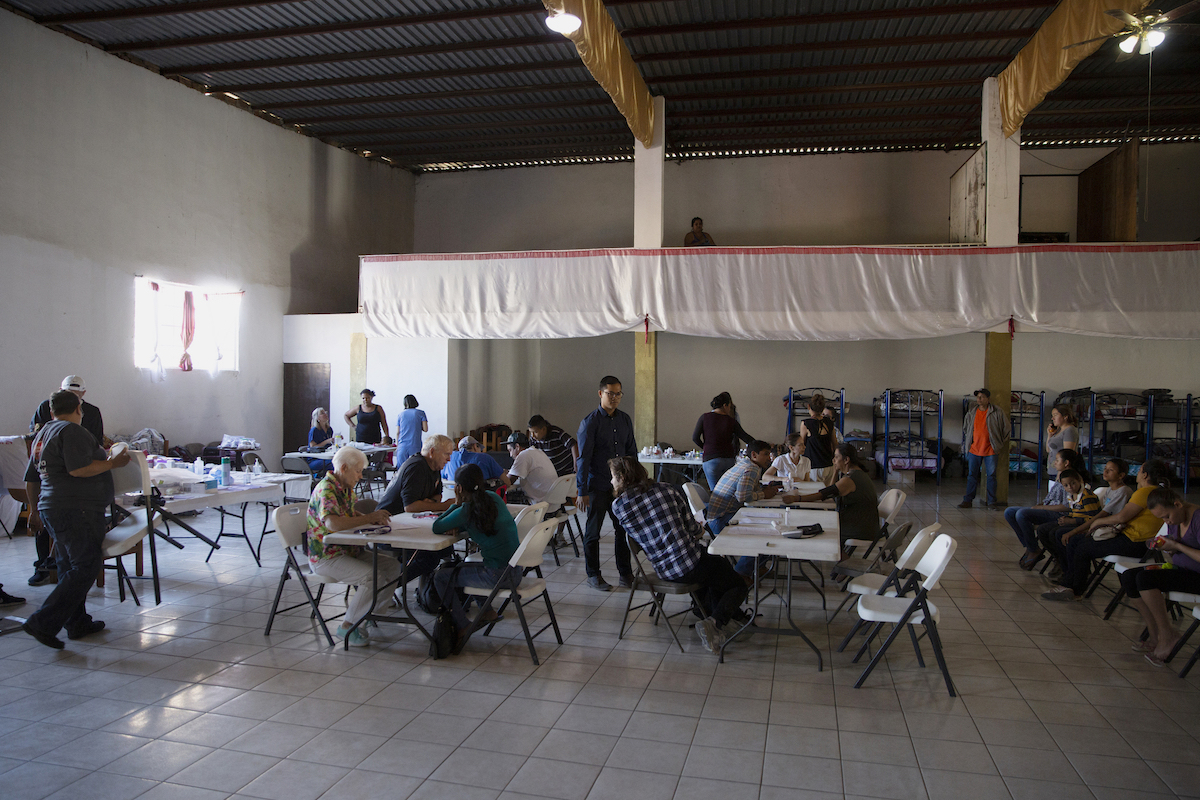

In this December 14, 2019 image, Psyche Calderón, center, pauses for a moment as she works alongside other volunteer health care professionals in a shelter for migrants in Tijuana, Mexico. (AP Photo/Gregory Bull)
By JULIE WATSON, Associated Press
TIJUANA, Mexico (AP) — When the Honduran boy complained of a toothache, Dr. Psyche Calderón asked the obvious question: “When did the pain start?”
The answer broke her heart.
“When La Mara broke all my teeth and killed all my family,” the 14-year-old said.
He said little else about the attack by the infamous Central American gang, La Mara Salvatrucha. Just: “I was the only one that survived.”
Calderón is not a therapist, nor a lawyer or a dentist. She is a general practitioner volunteering her time to provide care for Central Americans stuck in Mexico while they try to obtain asylum in the United States. There was little she could do for this teenager.
“So I gave him an antibiotic, then went home and cried,” she said.
Calderón is part of a movement of health professionals and medical students from both sides of the U.S.-Mexico border that is quietly battling to keep asylum seekers healthy and safe while their lives remain in flux.
They try desperately to tend to a need left largely unmet by the governments of both countries. It has thrust volunteer doctors into new and unusual roles where they often have to improvise while working with limited donated medications and equipment and dealing with non-medical issues. Besides giving patients a pill for pain relief, the doctors might need to direct them to legal help for their cases while offering a listening ear as a kind of therapist to a population suffering deep trauma from violence that forced them to flee their homelands.
With little training or preparation for this type of medical work, doctors like Calderón are trying to come up with guidelines to better treat migrants with emotional trauma.


In this December 14, 2019 image, Psyche Calderón works with a patient in a shelter for migrants in Tijuana, Mexico. (AP Photo/Gregory Bull)
Tens of thousands of people are stuck in Mexican border cities as their asylum cases wind their way through the U.S. court system under a Trump administration policy that returns them across the border to wait out a decision, rather than allowing them to stay with relatives or sponsors in the United States. Thousands of others wait for their numbers to be called so they can start their claim in a process that meters the number of asylum requests that are submitted to U.S. officials.
Many in Tijuana have lived for months at crowded shelters, sleeping on floors, with little access to public health clinics.
Along Mexico’s border with Texas, hundreds are living outside in tents made out of garbage bags. Families sleep near piles of human feces and bathe in the Rio Grande, known to be contaminated with E. coli and other bacteria.
In the Mexican city of Matamoros, the nonprofit Global Response Management bought flu vaccines from a local pharmacy at roughly $50 a dose to administer. Its volunteers set up sidewalk clinics to treat asylum seekers.
The health crisis spans both sides of the border. In the past year, at least three children, detained by U.S. Border Patrol agents, have died from the flu while being held. They include a 16-year-old boy who was seen on security footage writhing in agony on the floor in a U.S. Border Patrol holding cell.
Doctors recently protested outside a detention facility in San Diego to pressure the U.S. government to allow them to administer the flu vaccine to migrants for free, but so far Customs and Border Protection has refused, saying it is not equipped to run a vaccination program.


In this October 26, 2019 image, pediatrician Paulina Avendano jokes with a girl as she asks her to open her mouth wide during an examination at a shelter for migrants in Tijuana, Mexico. (AP Photo/Gregory Bull)
Meanwhile, in Tijuana, volunteers like Calderón have been going out to gritty, far-flung neighborhoods to set up pop-up clinics on the weekends at shelters that are rarely visited by Mexico’s public health doctors, if at all.
“I shouldn’t be doing this,” Calderón said. “They need to be in another place to be safe. That other place should be taking care of them, or the Mexican government should be taking care of these refugees.”
The 34-year-old Tijuana doctor treats addictions in her day job. Her private practice caters to Americans seeking lower-cost medical care across the border who pay in dollars, allowing her to be able to volunteer. She found her new calling in 2018 when thousands of Central Americans poured into Tijuana after crossing Mexico in a caravan.
Calderón, who slips in and out of English and Spanish seamlessly in a single sentence, grew up in Tijuana watching the border walls go up. At 11, she participated with her family in protests against California’s Proposition 187 that denied public education and health care to people in the United States illegally. At the age of 17, she shadowed doctors treating Mexicans deported to Tijuana from the U.S.
So when the caravan arrived, she reflexively went to the sprawling soccer field where they camped and start treating people. There she met other volunteers, including an emergency room physician from Los Angeles and a medical student from San Diego.
When the Mexican government closed down the festering soccer field camp, the volunteers realized the health crisis was not going away. So they joined forces under the Refugee Health Alliance, one of a handful of such groups along the 1,954-mile border.


In this October 26, 2019 image, UCSD medical student Phil Canete at right in dark blue shirt, addresses a group of volunteer health practitioners from Mexico and the United States before heading out to set up clinics at shelters for migrants in Tijuana, Mexico. (AP Photo/Gregory Bull)
Advocating for what they call “border-less medicine,” they started by organizing pop-up clinics at the shelters on Saturdays and attracting volunteers by word of mouth and through social media postings.
A year later, the Refugee Health Alliance has hosted 800 volunteers who have seen more than 9,000 patients; in addition to treatment, they document signs of torture and abuse for asylum cases. Volunteers also see asylum seekers during the week at a clinical space shared with a Mexican nonprofit that treats sex workers and drug addicts.
Each Saturday at 9 a.m., the volunteers gather less than a block from the towering border wall in Tijuana.
They improvise to overcome barriers. On a Saturday in October, a Chicago doctor who did not know Spanish used Google translate on his iPhone to tell a Guatemalan man and his family that he needed to go to the hospital because he likely had appendicitis. On the other side of the curtain, a Mexican midwife gave a Honduran woman who was eight months pregnant an ultrasound while talking over the mechanical iPhone voice conveying the urgent news about the man’s appendix.
The Refugee Health Alliance hopes to open its own clinic next year.
On the group’s 52nd consecutive Saturday at the shelters, a 24-year-old San Diego woman who moved to Tijuana to help coordinate the efforts gives volunteers a brief orientation.


In this October 26, 2019 image, volunteer health practitioners set up a clinic in a shelter for migrants in Tijuana, Mexico. (AP Photo/Gregory Bull)
Celeste Pain, who crosses back to San Diego daily to work at an outlet store, rattles off instructions: Don’t ask about people’s backgrounds, which could trigger traumatic memories, or take photographs. Fill out medical forms that ask for a person’s medical history, their court date and their number in line of those waiting to ask for asylum. Determine when the client will be crossing the border; they likely will be held in U.S. immigration detention centers, which could disrupt their care.
The volunteers also are given labels and told to put them on any medication they give to the asylum seekers so U.S. immigration officials will not take the pills away — though they often do, anyway.
They head out to the first stop, at the bottom of “Scorpion Canyon.”
There they meet Calderón traipsing past barking pit bulls, crowing roosters and pigs, lugging a massive duffel bag down a muddy, trash-strewn road. Two University of Arizona medical students jump in to help.
Calderón leads the dozen or so volunteers into a cavernous Christian church that first sheltered Haitians who flocked by the thousands to this border city in 2016. Now the church is filled with scores of tents housing Central Americans.
The two dozen volunteers include two pediatricians, a university professor who also practices medicine, medical students from Phoenix and San Francisco, a Stanford University psychology doctorate student who worked with children at refugee camps in Iran, and two sisters from Los Angeles who have relatives in Tijuana.
They unfold tables and metal chairs in the congregation hall to set up makeshift examining spaces as giggling children run by. They unpack a half-dozen duffel bags and suitcases bursting with plastic bags filled with asthma inhalers, antibiotics and other prescription drugs. Some medications were brought in by volunteers, including the two sisters who said they were stopped by Mexican customs officials and had to pay up to $100 before being allowed into the country.


In this October 26, 2019 image, a woman waits by the door as volunteer health practitioners set up a clinic in a shelter for migrants in Tijuana, Mexico. (AP Photo/Gregory Bull)
Calderón works between the church where she sees mostly Central Americans and a neighboring cluster of rooms built out of discarded doors and crates housing several dozen Haitians.
“Tenemos tongue depressors?” she asks one of the bilingual volunteers.
She sees a woman with a badly healed broken wrist, a girl’s belly covered with scabies, an undernourished pregnant woman, a baby with a cold, a toddler who is underweight, a woman with a swollen check and infected tooth, another with a red, swollen eye.
With a warm smile and a pink stethoscope around her neck, she sees patient after patient. She calls dentists, ophthalmologists and other specialists she knows to see if they are willing to see the patients she cannot treat.
Meanwhile she teaches the U.S. volunteers how to make do with the limited supplies and traditional equipment, like a non-digital blood pressure monitor. With no scale, she has learned to calculate weight by lifting babies under their arms. She scurries to a cinder-block room abutting a row of outhouses to find privacy to do a breast exam on a Honduran woman.
Eight months have passed since that day she saw the boy with the broken teeth. She still thinks of him. She never saw him again nor learned of his fate.
The experience made her a better doctor, she said. Now when Calderón asks about migrants’ pain, she treads carefully: A hurt neck, might be from getting a head smashed in by thieves. A case of acid reflux might stem from anxiety about not being in a safe place.
“When you see someone who comes to you with insomnia, with no hope, it’s really hard on us too. What do we say? What do we treat? Is this an illness?” she asks.
What’s more, how do doctors treat patients they are unlikely to see more than once?
“That’s why we’re trying to write the protocol for mental health, and trying to get experts for refugee medicine to help us out with these questions,” she said.
Five hours into this Saturday’s work, Calderón takes a sip from her thermos of water, which bears a sticker of a dog exclaiming: “This is fine.” It’s a stark contrast to what she feels. She always wishes she could do more.
But in some ways, it’s a reminder to herself as much as a reassurance to her patients: This is fine, even though it’s not, but it’s what she has to accept given the limitations, the barriers that have created these conditions of mothers, fathers and children living for months as campers using outhouses, water from buckets and spigots and sleeping on cement floors side by side.
Calderón learned to accept those limitations after treating the boy with the toothache. She took time off and sought therapy for herself, feeling overwhelmed. Then she took a course to learn how to treat patients who have endured tragedies.
“I need to be OK that I did something,” she said. “It’s a thing that all doctors come to understand at some point, right? I hope. We do what we can.”
***
The Associated Press produced this story with support by the Solutions Journalism Network. Associated Press Writers Sharon Cohen and Nomaan Merchant contributed to this report.


